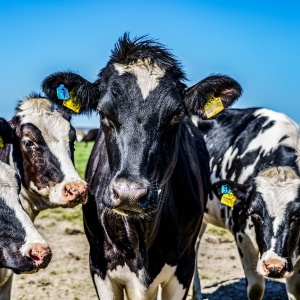
In this paper, FCRN member Nicholas Bowles of the University of Melbourne reviews existing data on the environmental impacts of the livestock sector and considers these impacts in the context of planetary boundaries. The paper reports that efficiency alone is unlikely to be adequate to shrink livestock’s impacts to a sustainable level, and that dietary shifts will also be necessary.
The figure below shows the livestock (excluding seafood) sector’s contribution to greenhouse gas emissions, interference in the nitrogen cycle and land-system change (i.e. deforestation). The grey bars show impacts for the reference year (2010 for greenhouse gas emissions and 2009 for the others), while the red bars show the additional impacts that are projected in 2050. Impacts are shown as a percentage of each estimated planetary boundary. By 2050, the livestock sector alone is predicted to occupy 60% of the planetary boundary for greenhouse gas emissions, exceed the boundary for the nitrogen cycle by 50%, and occupy 80% of the boundary for land-system change.
 Image: Figure 3, Bowles et al. Summary of impacts and mitigation potential relative to planetary boundaries. Safe operating space in each domain is represented by the green segment, while the yellow and red segments correspond to the zone of uncertainty and the zone of exceedance respectively. Reference impacts (REF) in each domain are represented by the red bars. Blue and grey bars in the MBE (mitigation by efficiency) and MBE-TAX (mitigation by efficiency plus a tax on production emissions) scenarios represent total mitigation potential from reference impacts.
Image: Figure 3, Bowles et al. Summary of impacts and mitigation potential relative to planetary boundaries. Safe operating space in each domain is represented by the green segment, while the yellow and red segments correspond to the zone of uncertainty and the zone of exceedance respectively. Reference impacts (REF) in each domain are represented by the red bars. Blue and grey bars in the MBE (mitigation by efficiency) and MBE-TAX (mitigation by efficiency plus a tax on production emissions) scenarios represent total mitigation potential from reference impacts.
For comparison, readers may wish to refer to the scenarios developed by the EAT-Lancet commission on healthy diets from sustainable food systems. See Figure 5 of the full report for the impacts of the food system under different scenarios in the context of permissible impacts under the planetary boundaries. Note, however, that the boundaries set out in the EAT-Lancet commission are based on the allowable impacts from the food system alone, not allowable impacts from all sources.
The paper notes that even if livestock’s impacts were to be decreased (compared to the reference scenario in 2050) through improved efficiency, then livestock alone would still occupy 107% of the planetary boundary for nitrogen. However, introducing a tax on greenhouse gas emissions would decrease demand for meat by 14% (mostly due to a reduction in demand for ruminant meat), according to the paper’s model, which would bring livestock’s nitrogen impact within the planetary boundary - albeit leaving only 7% of the emissions permitted within the boundary for other economic sectors or as a safety margin.
Abstract
The livestock sector is a key driver of humanity's transgression of several planetary boundaries, with the production of ruminant meat being particularly impactful. Given current trends in demand for animal products, strategies to significantly reduce the livestock sector's environmental impacts are urgently needed. Here we draw on published data to examine livestock's impacts in three key critical sustainability domains within the planetary boundaries framework – climate change, biochemical flows and land-system change, and seek to quantify livestock's occupation of humanity's safe operating space now and into the future (2050). We estimate that the livestock sector may already occupy the majority of, or transgress, humanity's safe operating space across these domains, with such impacts forecast to grow by 2050. Furthermore, we explore the potential of reasonably foreseeable technological measures to mitigate the sector's environmental impacts. While such measures are deemed necessary, their effects are unlikely to be sufficient to shrink the scale of livestock's impacts to a sustainable level, as defined by the three planetary boundaries tested. The implication of these findings is that macroeconomic policies promoting both sustainable production and consumption practices are integral to the realisation of a sustainable food system, where humanity functions within its safe operating space.
Reference
Bowles, N., Alexander, S. and Hadjikakou, M., 2019. The livestock sector and planetary boundaries: A ‘limits to growth’ perspective with dietary implications. Ecological Economics, 160, pp.128-136.
Read the full paper here. See also the Foodsource chapter What is a healthy sustainable eating pattern? and the paper A good life for all within planetary boundaries.







Post a new comment »